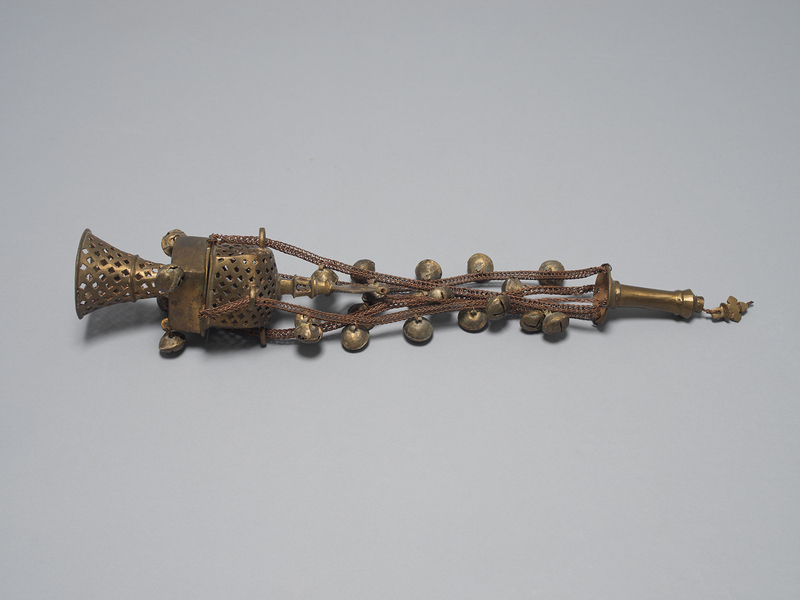Incense Burner Item Number: 3595/2 from the MOA: University of British Columbia


Description
Thurible, or censer (incense burner) with a conical base with diamond-shaped holes bored through the metal. Attached to the base is a rectangular dish with a protruding brim at the top and four bells on each bottom corner. The bells are attached to metal loops with copper-coloured wire loops. Four wire loops are attached in the centre of each side on the brim of the dish, from which long wire chains extend all the way to the top handle of the thurible. Above the rectangular dish is a semicircular lid with a protruding brim at the bottom, diamond-shaped holes bored through the metal, and four metal loops on each side, which the wire chains extend through. A bell is attached to one of these metal loops. Protruding from the top of the lid is a rectangular section that connects to a diamond shape, with a metal loop on top. Attached to this metal loop is another wire chain that goes all the way through the centre of the handle, in between the other four chains attached to the dish. The top of the central chain is tied onto a cross-shaped piece of metal, which has a wire loop tied around the top, likely used for lifting and lowering the lid. Two of the four wire chains attached to the base have five bells attached to each of them; while the remaining two chains have four bells attached to each. The lid is conical with a cylindrical upper section, a hollow centre that the central chain goes through, and four holes bored through the bottom, which the four wire chains attached to the base connect to.
History Of Use
A thurible is a metal censer suspended from chains, in which incense is burned during worship services. It is used in Christian churches, including the Orthodox Church in Ethiopia.
Narrative
Donated to the Kelowna Museum (now the Okanagan Heritage Museum) in 1990 by Mrs H. Patton, who collected the item in Ethiopia.
Item History
- Made in Ethiopia
- Owned by Okanagan Heritage Museum before September 14, 2022
- Received from Okanagan Heritage Museum (Transferring institution) on September 14, 2022
What
Who
- Culture
- Ethiopian
- Previous Owner
- Okanagan Heritage Museum
- Received from
- Okanagan Heritage Museum (Transferring institution)
Where
- Holding Institution
- MOA: University of British Columbia
- Made in
- Ethiopia
When
- Ownership Date
- before September 14, 2022
- Acquisition Date
- on September 14, 2022
Other
- Item Classes
- metalwork
- Condition
- good
- Accession Number
- 3595/0002